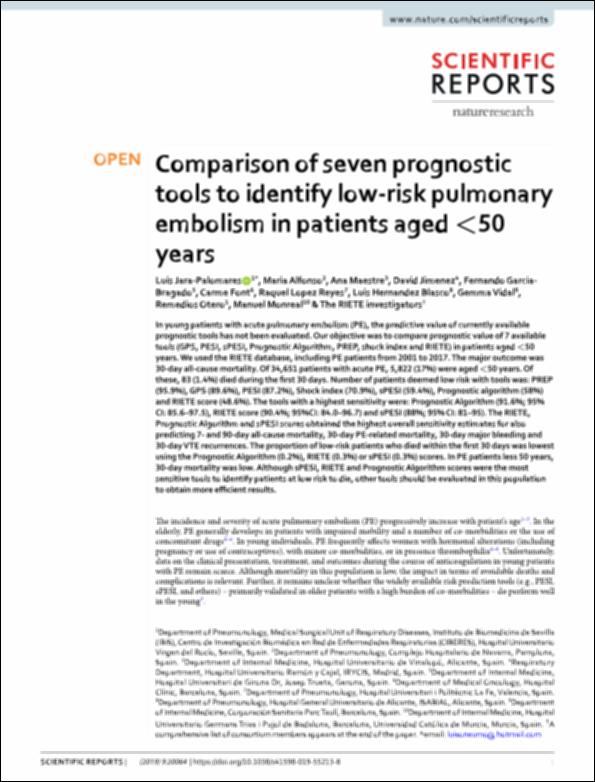Por favor, use este identificador para citar o enlazar este ítem:
http://hdl.handle.net/10637/10898Comparison of seven prognostic tools to identify low-risk pulmonary embolism in patients aged <50 years.
| Título : | Comparison of seven prognostic tools to identify low-risk pulmonary embolism in patients aged <50 years. |
| Autor : | Jara Palomares, Luis Alfonso Imizcoz, María Maestre Peiró, Ana Jiménez Castro, David García Bragado, Fernando Font Puig, Carme Peris Sifre, María Luisa |
| Materias: | Embolia pulmonar - Pronóstico.; Pulmonary embolism - Prognosis.; Cardiovascular system - Diseases - Prognosis.; Aparato circulatorio - Enfermedades - Pronóstico. |
| Editorial : | Springer Nature. |
| Citación : | Jara-Palomares, L., Alfonso, M., Maestre, A., Jimenez, D., Garcia-Bragado, F., Font, C. et al. (2019). Comparison of seven prognostic tools to identify low-risk pulmonary embolism in patients aged <50 years. Scientific Reports, vol. 9, art. 20064 (27 dec.). DOI: https://doi.org/10.1038/s41598-019-55213-8 |
| Resumen : | In young patients with acute pulmonary embolism (PE), the predictive value of currently available prognostic tools has not been evaluated. Our objective was to compare prognostic value of 7 available tools (GPS, PESI, sPESI, Prognostic Algorithm, PREP, shock index and RIETE) in patients aged <50 years. We used the RIETE database, including PE patients from 2001 to 2017. The major outcome was 30-day all-cause mortality. Of 34,651 patients with acute PE, 5,822 (17%) were aged <50 years. Of these, 83 (1.4%) died during the frst 30 days. Number of patients deemed low risk with tools was: PREP (95.9%), GPS (89.6%), PESI (87.2%), Shock index (70.9%), sPESI (59.4%), Prognostic algorithm (58%) and RIETE score (48.6%). The tools with a highest sensitivity were: Prognostic Algorithm (91.6%; 95% CI: 85.6–97.5), RIETE score (90.4%; 95%CI: 84.0–96.7) and sPESI (88%; 95% CI: 81–95). The RIETE, Prognostic Algorithm and sPESI scores obtained the highest overall sensitivity estimates for also predicting 7- and 90-day all-cause mortality, 30-day PE-related mortality, 30-day major bleeding and 30-day VTE recurrences. The proportion of low-risk patients who died within the frst 30 days was lowest using the Prognostic Algorithm (0.2%), RIETE (0.3%) or sPESI (0.3%) scores. In PE patients less 50 years, 30-day mortality was low. Although sPESI, RIETE and Prognostic Algorithm scores were the most sensitive tools to identify patients at low risk to die, other tools should be evaluated in this population to obtain more efcient results. |
| Descripción : | Este es el artículo que se ha publicado de forma definitiva en: https://www.nature.com/articles/s41598-019-55213-8 En este artículo también participan Raquel López Reyes, Luis Hernández Blasco, Gemma Vidal, Remedios Otero, Manuel Monreal & The RIETE investigators. |
| URI : | http://hdl.handle.net/10637/10898 |
| Derechos: | http://creativecommons.org/licenses/by/4.0/deed.es |
| ISSN : | 2045-2322 (Electrónico). |
| Fecha de publicación : | 27-dic-2019 |
| Centro : | Universidad Cardenal Herrera-CEU |
| Aparece en las colecciones: | Dpto. Medicina y Cirugía |
Los ítems de DSpace están protegidos por copyright, con todos los derechos reservados, a menos que se indique lo contrario.


